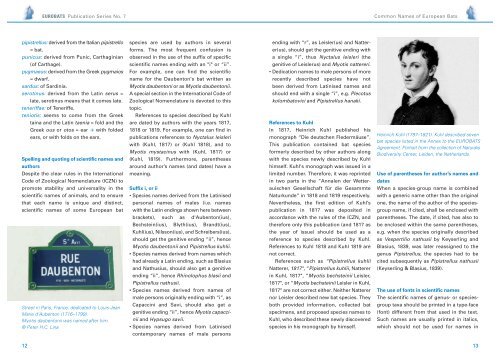FSCcertified
EUROBATS-Publication%20Series%20No.7_web
EUROBATS-Publication%20Series%20No.7_web
You also want an ePaper? Increase the reach of your titles
YUMPU automatically turns print PDFs into web optimized ePapers that Google loves.
EUROBATS Publication Series No. 7<br />
Common Names of European Bats<br />
pipistrellus: derived from the Italian pipistrello<br />
species are used by authors in several<br />
ending with “r”, as Leisler(us) and Natter -<br />
= bat.<br />
forms. The most frequent confusion is<br />
er(us), should get the genitive ending with<br />
punicus: derived from Punic, Carthaginian<br />
observed in the use of the suffix of specific<br />
a single “i”, thus Nyctalus leisleri (the<br />
(of Carthage).<br />
scientific names ending with an "i" or “ii”.<br />
genitive of Leislerus) and Myotis nattereri.<br />
pygmaeus: derived from the Greek pygmaios<br />
For example, one can find the scientific<br />
• Dedication names to male persons of more<br />
= dwarf.<br />
name for the Daubenton's bat written as<br />
recently described species have not<br />
sardus: of Sardinia.<br />
Myotis daubentoni or as Myotis daubentonii.<br />
been derived from Latinised names and<br />
serotinus: derived from the Latin serus =<br />
A special section in the International Code of<br />
should end with a single “i”, e.g. Plecotus<br />
late, serotinus means that it comes late.<br />
Zoological Nomenclature is devoted to this<br />
kolombatovici and Pipistrellus hanaki.<br />
teneriffae: of Teneriffe.<br />
topic.<br />
teniotis: seems to come from the Greek<br />
References to species described by Kuhl<br />
taina and the Latin taenia = fold and the<br />
are dated by authors with the years 1817,<br />
References to Kuhl<br />
Greek ous or otos = ear with folded<br />
ears, or with folds on the ears.<br />
Spelling and quoting of scientific names and<br />
1818 or 1819. For example, one can find in<br />
publications references to Nyctalus leisleri<br />
with (Kuhl, 1817) or (Kuhl 1818), and to<br />
Myotis mystacinus with (Kuhl, 1817) or<br />
(Kuhl, 1819). Furthermore, parentheses<br />
In 1817, Heinrich Kuhl published his<br />
monograph “Die deutschen Fledermäuse”.<br />
This publication contained bat species<br />
formerly described by other authors along<br />
with the species newly described by Kuhl<br />
Heinrich Kuhl (1797–1821). Kuhl described seven<br />
bat species listed in the Annex to the EUROBATS<br />
Agreement. Portrait from the collection of Naturalis<br />
Biodiversity Center, Leiden, the Netherlands.<br />
authors<br />
around author’s names (and dates) have a<br />
himself. Kuhl's monograph was issued in a<br />
Despite the clear rules in the International<br />
meaning.<br />
limited number. Therefore, it was reprinted<br />
Use of parentheses for author’s names and<br />
Code of Zoological Nomenclature (ICZN) to<br />
in two parts in the “Annalen der Wetter -<br />
dates<br />
promote stability and universality in the<br />
Suffix i, or ii<br />
auischen Gesellschaft für die Gesammte<br />
When a species-group name is combined<br />
scientific names of animals, and to ensure<br />
• Species names derived from the Latinised<br />
Naturkunde” in 1818 and 1819 respectively.<br />
with a generic name other than the original<br />
that each name is unique and distinct,<br />
personal names of males (i.e. names<br />
Nevertheless, the first edition of Kuhl’s<br />
one, the name of the author of the species-<br />
scientific names of some European bat<br />
with the Latin endings shown here between<br />
publication in 1817 was deposited in<br />
group name, if cited, shall be enclosed with<br />
brackets), such as d'Aubenton(ius),<br />
accordance with the rules of the ICZN, and<br />
parentheses. The date, if cited, has also to<br />
Bech stein(ius), Blyth(ius), Brandt(ius),<br />
therefore only this publication (and 1817 as<br />
be enclosed within the same parentheses,<br />
Kuhl(ius), Nilsson(ius), and Schreibers(ius),<br />
the year of issue) should be used as a<br />
e.g. when the species originally described<br />
should get the genitive ending “ii”, hence<br />
reference to species described by Kuhl.<br />
as Vespertilio nathusii by Keyserling and<br />
Myotis daubentonii and Pipistrellus kuhlii.<br />
References to Kuhl 1818 and Kuhl 1819 are<br />
Blasius, 1839, was later reassigned to the<br />
• Species names derived from names which<br />
not correct.<br />
genus Pipistrellus, the species had to be<br />
had already a Latin ending, such as Blasius<br />
References such as “Pipistrellus kuhlii<br />
cited subsequently as Pipistrellus nathusii<br />
and Nathusius, should also get a genitive<br />
Natterer, 1817", “Pipistrellus kuhlii, Natterer<br />
(Keyserling & Blasius, 1839).<br />
ending “ii”, hence Rhinolophus blasii and<br />
in Kuhl, 1817", “Myotis bechsteinii Leisler,<br />
Pipistrellus nathusii.<br />
1817", or “Myotis bechsteinii Leisler in Kuhl,<br />
• Species names derived from names of<br />
1817" are not correct either. Neither Natterer<br />
The use of fonts in scientific names<br />
male persons originally ending with “i”, as<br />
nor Leisler described new bat species. They<br />
The scientific names of genus- or species-<br />
Street in Paris, France, dedicated to Louis-Jean<br />
Marie d’Aubenton (1716–1799).<br />
Myotis daubentonii was named after him.<br />
© Peter H.C. Lina<br />
Capaccini and Savi, should also get a<br />
genitive ending “ii”, hence Myotis capaccinii<br />
and Hypsugo savii.<br />
• Species names derived from Latinised<br />
contemporary names of male persons<br />
both provided information, collected bat<br />
specimens, and proposed species names to<br />
Kuhl, who described these newly discovered<br />
species in his monograph by himself.<br />
group taxa should be printed in a type-face<br />
(font) different from that used in the text.<br />
Such names are usually printed in italics,<br />
which should not be used for names in<br />
12<br />
13


